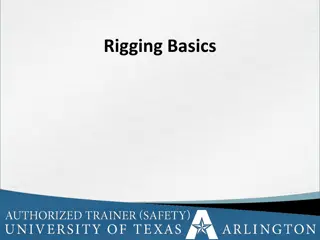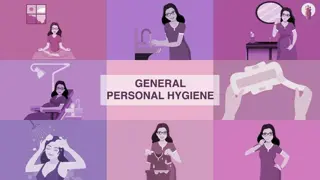Understanding Industrial Hygiene: Importance, Hazards, and Control
Industrial hygiene is a crucial field focused on anticipating, evaluating, and controlling environmental factors that can impact workers' health. This introduction covers topics such as exposure pathways, types of hazards, health effects, risk assessment, and careers in industrial hygiene. It delves into the relevant sciences and studies involved, different government agencies, and professional organizations in the field.
Download Presentation

Please find below an Image/Link to download the presentation.
The content on the website is provided AS IS for your information and personal use only. It may not be sold, licensed, or shared on other websites without obtaining consent from the author. Download presentation by click this link. If you encounter any issues during the download, it is possible that the publisher has removed the file from their server.
E N D
Presentation Transcript
CHAPTER 1 Introduction to Industrial Hygiene
Learning Objectives Briefly explain the relevance and importance of the practice of industrial hygiene in society today and throughout history. Explain the types of sciences and studies that comprise the field of industrial hygiene. Describe the differences between pathways of exposure and routes of exposure to hazardous agents. List general types of workplace hazards. Identify the basic health effects of hazardous exposures in the workplace. Describe the concept of risk and the fundamental principles that it is based upon. Discuss the basic tenets of industrial hygiene hazard assessment and control. Recognize the types of careers and industries available for professional industrial hygienists. Briefly describe the various government agencies and professional organizations with roles in industrial hygiene.
Industrial Hygiene Definition That science and art devoted to the anticipation, recognition, evaluation, and control of those environmental factors or stresses arising in or from the workplace that may cause sickness, impaired health and wellbeing, or significant discomfort among workers or among the citizens of the community (AIHA).
Industrial Hygiene Today Chemistry Physics Physiology Anatomy Toxicology Mathematics Biology Statistics Epidemiology Engineering Psychology/organizational behavior Social science Ergonomics Risk assessment Management Ethics
Pathways of Exposure Air Water Food Animals People Surfaces
Significant Routes of Exposure Inhalation Skin and eye absorption What does skin notation mean? Ingestion Percutaneous Source: National Institutes of Health, http://www.nhlbi.nih.gov/health/health- topics/topics/hlw/system
Chemical Hazards Flammable Reactive Corrosive Toxic Explosive Carcinogenic Sensitizing
Physical Hazards Noise Ionizing radiation Nonionizing radiation Thermal stress (hot/cold) Vibration
Musculoskeletal Hazards Force Duration Awkward posture Repetitive
Biological Hazards Infectious Disease causing
Injury versus Disease Injury = direct physical outcome Disease = may involve a progression
Acute Exposure An exposure that occurs over a short period
Chronic Exposure A lower level exposure that occurs over a long period of time Days, weeks, months, years
Acute Health Effects Seen shortly after exposure May be reversible Hearing loss Headache Dizziness Skin redness
Chronic Health Effects May take a long time to occur or notice Cancer Bone degeneration Hearing loss Silicosis Emphysema
Risk Probability a branch of mathematics that measures and describes the relative likelihood or frequency of an event and looks at the distributions of the event s occurrences within a given population. Severity The level of hazard associated with a possible exposure
Anticipation Identifying potential or actual hazards through knowledge of materials, operations, processes, and conditions in the workplace. Using available information from a variety of sources.
Recognition The observation and discovery of the hazardous materials and conditions in the workplace. Using observation and process mapping to understand and document processes and possible exposures to workplace hazards.
Evaluation Measure exposures and doses, and comparing the measurements to regulatory, professional, and other exposure standards and limits. Measures could include air monitoring, ergonomic observations, review of accident and injury records, and worker interviews. Quantitatively evaluate and document levels of exposure. Prioritize jobs with the most significant hazards.
Control of Hazards The elimination or reduction of identified and measured hazards. Use the hierarchy of controls to eliminate or reduce hazards.
Elimination and Substitution Completely eliminate the hazard from the workplace. Stop the use of a particular toxic or flammable chemical used in the process or product. Reduce the quantity of a particular hazardous chemical used. Change the chemical to a safer or less hazardous one. Change the work process to cut out the hazardous activity or materials used.
Engineering Controls Structures, systems, or devices that physically separate, or protect the worker from the hazard. Barriers, walls, enclosures, covers, guards, shields. Ventilation systems, fume hoods. Distance (moving the hazard farther away from the workers).
Administrative Controls Programs Policies Procedures Labels Warning signs or lights Training
Personal Protective Equipment Respirators Gloves Lab coats Eyewear Footwear Lead aprons Face shields Ear muffs
Industry Careers Manufacturing Health care Research/education Transportation Insurance Agriculture Public utilities Construction Energy Waste management Mining
Government Careers Environmental Protection Agency Federal Communications Commission Nuclear Regulatory Commission National Institutes of Health s Center for Disease Control and Prevention Public Health Service Chemical Safety Board National Institute for Environmental Health Studies Consumer Product Safety Commission Department of Energy Mine Safety and Health Administration National Transportation Safety Board
Job Paths Consulting Laboratory analysis Management Exposure assessment and control Research Policy and regulation development and analysis Quality assurance Ergonomics Noise assessment and control Radiation safety
Professional Organizations American Industrial Hygiene Association American Society of Safety Engineers American Conference of Governmental Industrial Hygienists National Safety Council Health Physics Society Human Factors and Ergonomics Society American National Standards Institute























